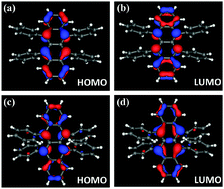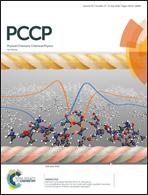Electronic structure of twisted and planar rubrene molecules: a density functional study†
Abstract
X-ray absorption spectra (XAS), the density of states (DOS) and the electron density distribution of the HOMO and LUMO for flat and twisted rubrene molecules have been calculated using density functional theory (DFT). The simulated XAS spectra are validated by experimental C K-edge near-edge X-ray absorption fine structure (NEXAFS) data. We demonstrate that the NEXAFS spectra of rubrene thin films of different thicknesses can be explained in terms of different combinations of spectral intensity from the twisted and the flat randomly oriented molecules. All the fine structure of the NEXAFS spectra is well reproduced and the energetic positions of the resonances agree within a window of ±0.3 eV with the calculated XAS. Our calculation reveals that the peak at lowest photon energy (α′) of the NEXAFS spectra at the lower coverage of rubrene molecules appears only from the twisted molecules. Other peaks in the case of the flat molecules appear either from the backbone or the wings, whereas, for the twisted molecules, the backbone and the wings contribute somewhat equally. Lowering of the HOMO–LUMO gap, as well as redistribution of the electron density of both the frontier orbitals, is found to take place in the case of the twisted molecule. The redistribution explains the reduction in conductivity for the twisted molecule compared to the flat one despite the lower band gap for the former. This finding will further strengthen the progress of rubrene thin film based devices.



 Please wait while we load your content...
Please wait while we load your content...